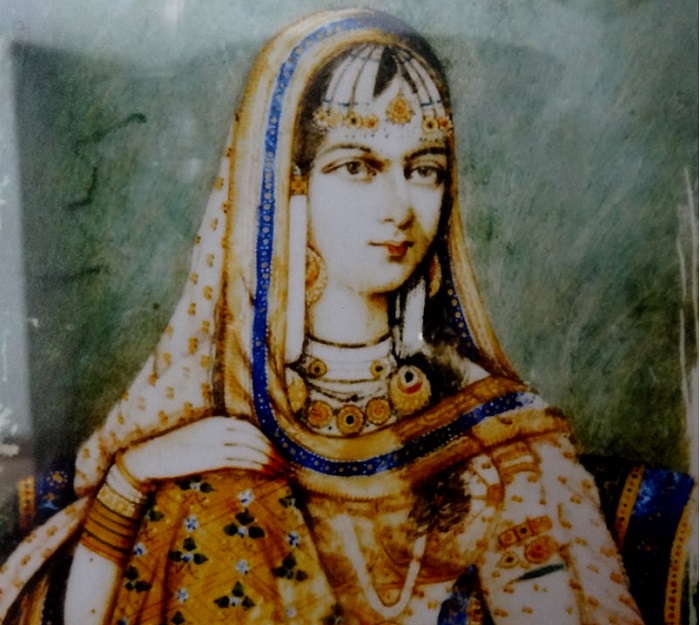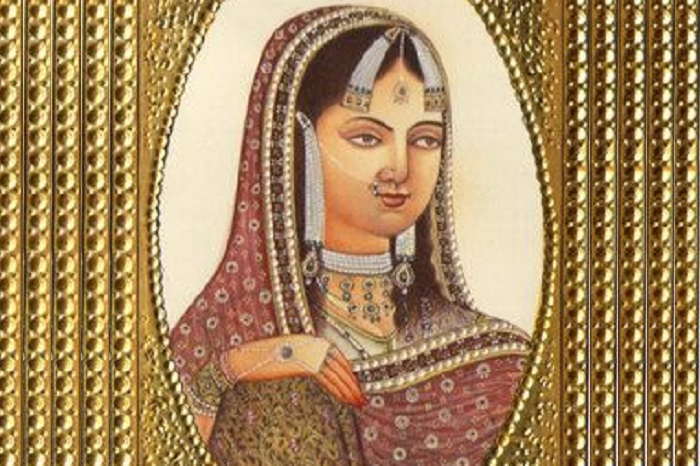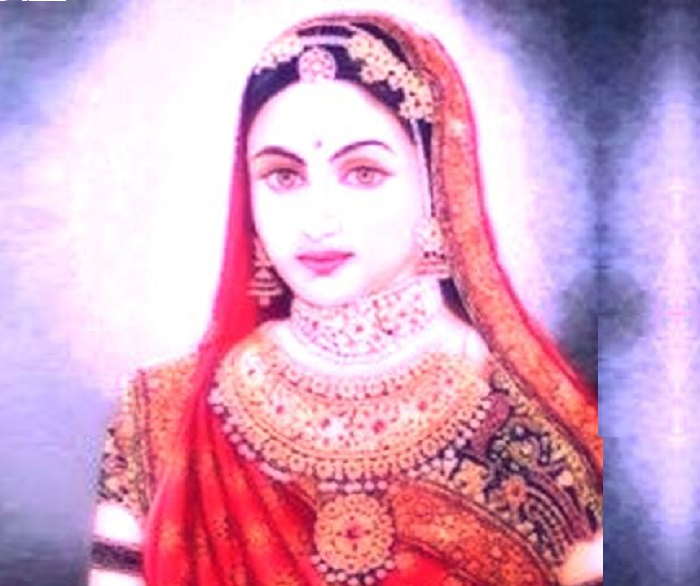Fast Facts
Date of Birth: c. 1542
Place of Birth: Amer kingdom, Rajputana
Death: May 19, 1623
Place of Death: Agra, Mughal Empire, (Presently India)
Spouse: Akbar (m. 1562–1605)
Buried: Tomb of Mariam-uz-Zamani, Bainpur Mustkil
Parents: Bihari Mal, Rani Sa Manvati Sahiba
Children: Jahangir
Mariam-uz-Zamani was the chief and first Rajput wife of the third Mughal emperor, Akbar. She was a Rajput princess born to Raja Bihari Mal (or Bhar Mal) of Amer (Jaipur). Although her actual name is not known, an 18th-century genealogy of Kachwaha Rajputs, the clan she belonged to, refers her as Harkhan Champavati . She is also known by names Hira Kunwari, Harkha Bai and Jodha Bai, the latter points out that by birth she might have been a princess of Jodhpur. Her marriage with Akbar was a diplomatic and political alliance, which marked the acceptance of Akbar’s suzerainty by Raja Bihari Mal. The marriage was a significant event in the history of the Mughal Empire as it brought about a progressive change in the Mughal religious and social policies that were more benevolent to the multi-ethnic and multi-denominational empire. Mariam-uz-Zamani gave birth to Akbar’s eldest surviving son, Jahangir, who succeeded Akbar to become the fourth Mughal Emperor.
Early Life & Marriage with Akbar

Image Credit : https://www.flickr.com/photos/lyallpur/8456849811
She was born in c. 1542 in Amer kingdom to Rajput ruler Raja Bihari Mal and his wife Rani Mainavati. Amer, later known as Jaipur, is in modern-day state of Rajasthan, in India. Bihari Mal once helped Mughal commandment Majnun Khan Qaqshal in 1556 and after hearing about it Akbar sent invitation to Bihari Mal to come to his Delhi court and rewarded him. The Kachwahas faced persecution in 1562 after Akbar’s brother-in-law Mirza Muhammad Sharaf-ud-din Hussain, the Mughal hakim of Mewat, was inducted Mughal governor of Mewat. Mirza invaded Amer and overpowered Bihari Mal and the Kachwahas who were forced to leave Amer and stay in the hills and forests. Although Bihari Mal promised to pay peshkash (fixed tribute) to Mirza and gave his son Jagannath and two nephews Khangar Singh and Raj Singh to the latter as hostages for the due payment, Mirza still readied himself for a repeat invasion to Amer. At this point Bihari Mal approached Akbar’s courtier Chaghtai Khan and narrated the plight of the Kachwahas while the emperor was on his way to Ajmer to offer prayers to the tomb of Moinuddin Chishti. Hearing about the situation from Chaghtai Khan, Akbar summoned Bihari Mal to his court. On January 20, 1562, Bihari Mal met the emperor at his camp at Sanganer. Bihari Mal suggested giving his eldest daughter Hira Kunwari’s hand in marriage to Akbar which the latter agreed. Mirza surrendered Jagannath, Khangar Singh and Raj Singh to Akbar after the latter arrived in Sambhar, Rajasthan from Ajmer. The marriage ceremony of Akbar and Hira Kunwari was also held in Sambhar at the imperial military camp on February 6, 1562.
Matrimonial alliances were also established with Akbar by other Rajput kingdoms. Though neither of the Rajput wives of Akbar took a political role in the Mughal court, he respected such matrimonial alliances and treated his Hindu relatives on par with his Muslim relatives in all respects, however with exception of dining and praying with him or in taking Muslim wives. He never forced his Hindu wives to convert to Islam and allowed the Hindu women of his harem to conduct religious ceremonies and observances in the palace and on certain occasions he would also participate in such rituals. Thus Hira Kunwari remained a Hindu by faith.
As Mariam-uz-Zamani
Akbar visited Sufi saint, Salim Chisti, a descendant of Khwaja Moinuddin Chishti of Ajmer, in his home in Sikri and requested him to pray for a male heir for the Mughal Empire. Chisti blessed Akbar and promised him three sons. So when Akbar got the news in 1569 that his first Hindu wife was expecting a child, he hoped the birth of the first of his three sons as promised by the revered holy man Chisti. Akbar then sent Hira Kunwari to the dwelling of Chisti in Sikri to stay there till childbirth. On August 30, 1569, Hira Kunwari gave birth to a boy who was named Salim by his father out of his gratitude and honour towards the holy man. Salim later succeeded his father to become Emperor Jahangir. After she gave birth to Salim, Hira Kunwari was bestowed with the honorary title of Mariam-uz-Zamani (“Mary of the Age”). This was in line with the practice of the Mughal Empire of giving honorary titles to the Muslim noblewomen of the imperial harem after they give birth to a son.
Elevation of Her Family Members
Her marriage with Akbar created a close association between the Mughal Empire and her family which proved extremely beneficial for the latter with respect to gaining both power and wealth. Akbar inducted Bihari Mal as a noble of high rank in the imperial court. The Kachwaha relatives of Akbar including eldest son of Bihari Mal, Bhagwant Das and his son Man Singh served the Mughal Empire diligently. Bhagwant Das who succeeded Bhar Mal as Raja of Amber became a general of the Mughal Empire and was awarded a mansab (rank) of 5000 by Akbar in 1585. He fought several battles for Akbar, remained governor of Kabul and was bestowed with the title of Amir-ul-Umra (Chief Noble) by the latter. On February 13, 1585, Bhagwant Das’s daughter Manbhawati Bai or Man Bai was married to Prince Salim, who later became Emperor Jahangir and conferred Man Bai the title of Shah Begum. Bhagwant Das’s son Man Singh emerged as one of the trusted generals of Akbar and became commander of 7000 cavalry in the Mughal forces on August 26, 1605. Akbar made Man Singh one of the Navaratnas (nine gems) of the royal court and later Man Singh’s daughter Manorama Bai was married off to Dara Shikoh, eldest son and heir-apparent of fifth Mughal emperor Shah Jahan. In the list of mansabdars (commanders )mentioned by Abu’l-Fazl, the Grand vizier of Akbar, 13 out of 27 Rajputs were from the Amber clan, of whom some were even elevated to positions at par with the royal princes.

Image Credit : https://angel1900.wordpress.com/2013/11/16/hira-kunwari-mariam-uz-zamani/
As Queen Mother of Hindustan
Although during reign of Akbar, Mariam-uz-Zamani garnered status of his chief wife and had supremacy in the imperial harem as mother of heir-apparent, she earned more prestige as the emperor’s mother after her husband died on October 27, 1605 and her son Salim became fourth Mughal Emperor Jahangir on November 3, that year. She emerged as one of the most stupendous women traders at the Mughal court during her son’s reign. She was a business woman with insight and acumen who ran international trade in several items including silk and spices and was perhaps the most enterprising trader among other noblewomen on record.
She was the owner of ships that took pilgrims to Mecca the holiest city in the religion of Islam and carried them back home. Among them Rahīmī known to the Europeans as the “great pilgrimage ship” was the largest Indian ship that was sailing in the Red Sea. In one instance the Portuguese pirates captured the ship in 1613 that was carrying a large cargo of 100,000 rupees and around 600 to 700 passengers. The Portuguese officially denied return of both the ship and its passengers and when such news reached the Mughal court, Emperor Jahangir, the doting son of Queen mother of Hindustan was outraged. He gave orders to capture the Portuguese town Daman and also to take into custody all Portuguese within the Mughal Empire. Churches of the Jesuits were also confiscated by him.
Every year during New Year’s festival, the Queen mother would receive a jewel from each nobleman. Jahangir held his mother in high regards which among other things is palpable from the right he granted to her to issue firmans that is official orders that generally remained the absolute right of the emperor. Only a few noblewomen of the Mughal Empire were privileged with such right like Nur Jahan, wife of Jahangir, and Mumtaz Mahal, wife of Shah Jahan. Many architectural works including building gardens, mosques and wells were commissioned by the Queen mother. Many regal functions were held in her household including Jahangir’s solar weighing; marriage of Jahangir’s son Shehzada Parviz with Sultan Murad Mirza’s (Mughal prince and second surviving son of Akbar) daughter Princess Jahan Banu Begum in 1606; and Jahangir’s marriage to Koka Kumari Begum, eldest daughter of Yuvraj of Amber Jagat Singh, on June 17, 1608.
Jahangir built the Begum Shahi Mosque, officially known as ‘The Mosque of Mariyam Zamani Begum’ between 1611 and 1614 in honour of his mother. It is located in the Walled City of Lahore, in modern-day Pakistan.

Image Credit : https://www.facebook.com/Mariam-uz-zamani-1407833932790697/
Death & Legacy
She died on May 19, 1623, in Agra, Mughal Empire. Jahangir built a mausoleum in her memory (1623–27) called the Tomb of Mariam-uz-Zamani, which is located in Sikandra, a suburb of Agra. It lies around half a kilometre away from the Tomb of Akbar the Great.
Screen adaptations on life of Mariam-uz-Zamani includes the February 15, 2008, released commercially hit Indian historical-romance film ‘Jodhaa Akbar’ starring Indian actors Aishwarya Rai and Hrithik Roshan in titular roles. An Indian historical-fiction-drama television series titled ‘Jodha Akbar’ starring Paridhi Sharma and Rajat Tokas in lead roles also aired on Zee TV from June 18, 2013 to August 7, 2015.


